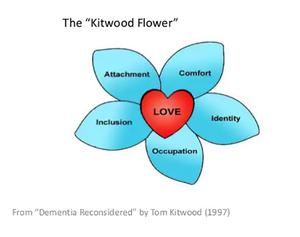Dementia not only impacts the person living with dementia but also those people who are involved in providing care and support to this person. Principles of Supportive Care for People with Dementia (CAD104) is a popular unit in the Diploma and Bachelor of Dementia Care program at the Wicking Dementia Centre. This unit takes you on a journey through dementia from the perspective of the person living with dementia as well as the people who care and support them.
Over Spring Semester 2020 there were over 400 students enrolled to undertake this unit. Jennifer, a former student who successfully completed this unit, describes why she chose this particular unit to study, her experience whilst undertaking the unit and how it has gone on to impact her views about dementia care practice and the way we support people living with dementia and their caregivers.
After working as an Assistant in Nursing for over 20 years I moved across to the education field and now teach the Individual Support course for a Registered Training Organisation. In July 2020, I enrolled in the Diploma of Dementia Care to improve my knowledge of dementia, to better work with people living with dementia, and to help me improve the knowledge of my students before entering employment in aged care. The unit CAD104, Principle of Supportive Care for People Living with Dementia is a core unit of the diploma course. The content of the unit has been very beneficial to my education work and more importantly, to my interactions within the aged care facilities.
This unit explores models of support that are inclusive of the broader care network and considers how support needs change at different points along the dementia trajectory. On the dementia trajectory, there is the potential for the person with dementia to transition to many different care settings (Fortinsky & Downs, 2014). A care transition on the dementia trajectory occurs when a person moves between or within support interventions (Runge et al., 2009). These are points in which the need for supportive approaches for the person with dementia and those involved in their care are likely to increase.
Content within this unit explores some of the issues associated with dementia, including the difficulties of getting a diagnosis and the impact of this ‘early’ or ‘timely’ diagnosis has on the person with dementia and their supportive networks.
An early diagnosis follows a chronological approach, that is:
> The person shows early signs of cognitive impairment
> Assessment of the person
> Possible early diagnosis of mild cognitive impairment or dementia
There are benefits and risks to an early diagnosis. For example, finding out early allows the individual and their families to prepare for the trajectory of the condition. However, what if the person does not want to know, especially as dementia has no cure, what is the potential benefit of finding out early?
A ‘timely diagnosis’ is an alternative approach and takes on a more holistic approach of the person. It has similar advantages and disadvantages to an ‘early’ diagnoses, however with a timely diagnosis, the individual circumstances of the person are taken more into consideration. It does not follow a chronological approach. Considerations as to whether there is value for the individual and their families in receiving the diagnosis are made. How will the diagnosis impact on the person and their relationships? Is there potential for stigma and the psychological impacts to the person and their family? What resources are available to support this person and their family? If the person is young and still working, how will this impact their work and insurances etc?
Should we diagnose people in a timely manner, or should we diagnose early? Is there a difference in these two choices? Before I completed CAD104 I would have said it is the same question, but I now know they are significantly different, and it helps to understand this when talking to people with dementia, their family, friends, and caregivers.
Currently, there is no cure for dementia, so the focus of this unit is on enabling the best quality of life for the person with dementia and their families and responding effectively to symptoms, problems and issues that arise along their unique dementia trajectory.
After looking at the dementia trajectory and the transitions that occur, including diagnosis, the unit explores the impact of dementia on caregivers and recognising the needs of the caregiver. The unit introduces theoretical concepts such as Kitwood’s person-centred approach to care and how this model helps to support people with dementia.
Studying Kitwood’s person-centred care approach and the challenges that poses to ensure we always support people with dementia in a dignified way will help change the approach many people have toward a person with dementia.
Kitwood was a pioneer in person-centred care. Exploring Kitwood’s model in greater detail allows students to understand that the approach we take is that the person is equal to others around them and that having a diagnosis of dementia does not make the person inferior to others. In other words, the diagnosis of dementia does not define who you are. Kitwood emphasised that support and caregivers should focus on the abilities that the person with dementia retains as they go along their trajectory of dementia illness.

Tom Kitwood, Bradford Dementia Group/University (1997)
Kitwood also indicates that person-centred care involves supporting the concept of ‘personhood’ as cognition declines. Personhood is defined as “a standing or status that is bestowed upon one human being by others, in the context of relationship and social being. It implies recognition, respect and trust”. (Kitwood, 1997, p.8)
To ensure personhood is achieved, the psychological needs of a person must be met. These psychological needs are represented on the flower and the overlapping petals present the overlap of these needs. Further in this unit, students explore how psychological needs of the person can be further supported or undermined which influence personhood of the person living with dementia.
Students begin to build upon principles of person-centred care. The unit explores underlying causes of behaviour as well as how the physical environment may impact on the person living with dementia.
And what about the environment around us? The physical setting can affect the independence of a person with dementia so much, and yet, we do not give it a lot of thought. Aged care facilities often go for aesthetics before function, shopping centres and other community places do not always consider people with dementia when designing buildings. This unit helped me understand the importance of the physical environment for supporting people with dementia”
By the end of the unit, students such as Jennifer report their satisfaction having undertaken this unit as part of their diploma or degree.
This unit has changed the way I view so many aspects of supporting people with dementia. It has changed the way I look at the physical world and the person who has dementia. After 20 plus years in aged care I thought my knowledge of dementia was relatively good, I thought I knew how to support a person with dementia quite well, but it has amazed me how one unit can change the way I approach supporting people with dementia. Was I a bad carer? No, but now I will be a better carer with much more insight into the world of people living with dementia. I still have a lot to learn, and I am happy to be a lifelong learner, and this course has added considerably to this understanding. The knowledge you can gain from these courses can only benefit the outcomes for people with dementia which, after all, is our objective.
